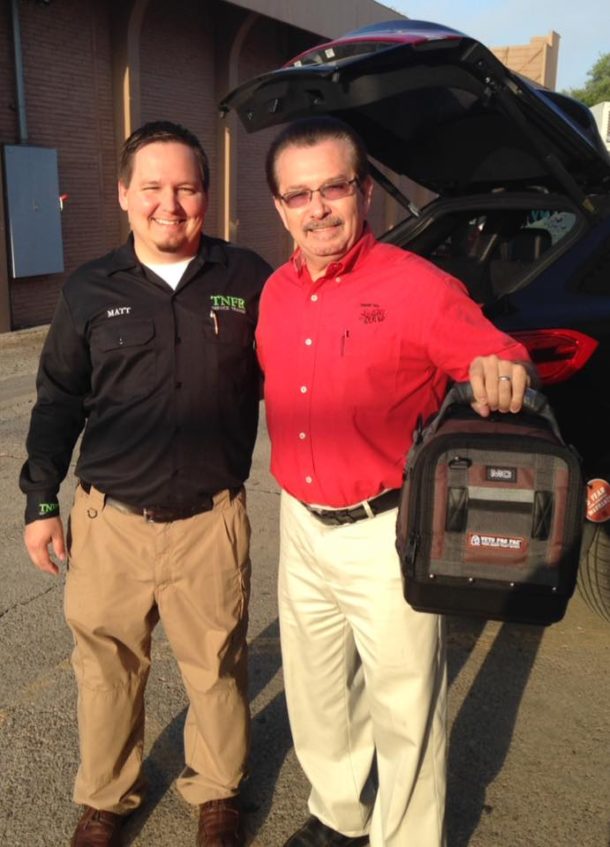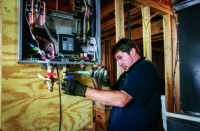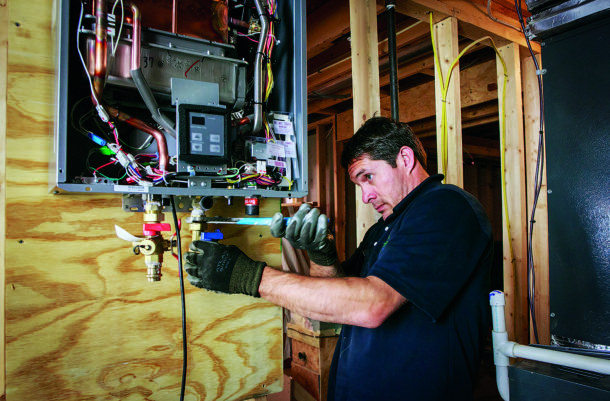When you think about the issue of sustainability in business marketing, you may think of how it connects to Fortune 500 companies that have businesses that reach around the globe. The reality is that sustainability is an issue that is of great importance to many people and impacts the way they choose the products and Read more
Guest Blog

When you think about the issue of sustainability in business marketing, you may think of how it connects to Fortune 500 companies that have businesses that reach around the globe. The reality is that sustainability is an issue that is of great importance to many people and impacts the way they choose the products and services they will pay for. It does not matter if it is a service that is offered by a multinational company or a local plumber. For this reason, even small businesses and one-person operations need to show that they pioneer sustainable business practices.
Showcasing Sustainability for Trade Marketing Success
As a tradesperson, you have worked hard to develop your craft and to build your reputation. However, in this current market, being a good craftsman or having a good product is not enough to win customer favor. Your clients will want you to do quality work, but they are also going to want to know that the tools you use, the products you use, the systems you use, and the way you handle any trash or debris align with their stand on environmental values.
If you can prove that your company stands for an environmental purpose, you will attract more customers. That is because, in today’s business climate, customers want to work with businesses that promote sustainability.

More Than Just a Buzzword
A few years ago, sustainability was a buzzword that you would hear thrown about haphazardly. This was true if you were discussing economic, social, or environmental sustainability. Today, people, and especially millennials, have keyed in on what sustainability means. For them, it means having processes and knowledge to exist continually.
When it comes to marketing your plumbing company, HVAC company, or framing company, you need to show the steps that your business is taking to proceed endlessly. What is meant by that is you need to show how your business is using resources wisely so that both your business and the environment can endure.
You need to show how your business will meet your customer’s needs today while not compromising the future generation’s ability to fulfill their needs. It is all about making your marketing and sustainability run parallel to each other.
Sustainability needs to be discreetly woven through everything you do, including your social media posts, your website, and your email newsletters. Customers must walk away with the feeling that your organization respects the environment and the social aspects around you. You can show this by using and promoting products and services that don’t harm the environment. Showcase the techniques your organization uses that are environmentally friendly.
For it to be successful, your sustainable marketing cannot be done in an ironic, sarcastic, or fantastic way. People have a good nose for fake things. When it comes to environmental issues and sustainability, people do not like to be pandered to. If your organization promises that they are going to build a building or do a remodel sustainably and then contractors or technicians are not using sustainable processes, your reputation could be irrevocably damaged.
Employing Sustainable Marketing Principles
Sustainability starts with customer-oriented marketing. This means viewing your organization and its activities from the perspective of your customers. Only by understanding the way your customers view environmental issues can you create long-term relationships with them.
You want to transmit the idea that your company is socially responsible and that you have found a way to do socially accountable activities profitably. This means that your mission should be defined in broad social terms instead of narrowing it to the products or services you offer.
Conclusion
Integrating sustainable marketing is a crucial business strategy for the trade industry. First and foremost, sustainability is about the survival of the human race. Second, it is about the survival of your business.
The business ecosystem is constantly changing. This requires people to adapt to and anticipate what is next. This means adding sustainable marketing to your overall marketing campaign. The last thing that you want is to see rival companies making moves toward sustainability before you. If that happens, it could seem like your move toward sustainability is either an effort to copy your competition or being done to make money.
 Author Bio: Victoria Smith is a freelance writer who specializes in business and finance, with a passion for cooking and wellness. She lives in Austin, TX where she is currently working towards her MBA.
Author Bio: Victoria Smith is a freelance writer who specializes in business and finance, with a passion for cooking and wellness. She lives in Austin, TX where she is currently working towards her MBA.

“You called the right place! How can we make you smile?” See how easy it was to catch your attention with a simple greeting? You would be surprised how often a simple acknowledgment of the customer will improve an online review. When working in the home service industry, customer service is your brand. It’s what Read more
“You called the right place! How can we make you smile?”
See how easy it was to catch your attention with a simple greeting? You would be surprised how often a simple acknowledgment of the customer will improve an online review. When working in the home service industry, customer service is your brand. It’s what people remember about you long after a job is completed. It’s the thing that can help drive your business to the next level.
As service providers, it is important to realize that, in today’s world, communicating with your customer directly, has become a necessity. With people finally getting a chance to converse face-to-face after a long period of strict social distancing guidelines, the customer wants to get to know you. No longer can we as service providers hide behind the bag in 2021. Which means it’s the perfect season for sharpening our soft skills such as controlling voice patterns and body language now that we are spending more time face to face. These skills are vital when communicating with customers.
Communicating with a customer is about building professional trust. When a customer feels that you have listened to them and understood what they need, they trust that you can accomplish the job and that expectations are clear. That is when the skills we’ve mastered as service providers come into play, and we follow through with what we promised our customers. This allows your team to ask the customer for additional and referral business, as well as that five-star review that will help create credibility online.
The Wow Factor
The No. 1 rule of any service provider is to go above and beyond expectations. We call this the “wow factor.” The wow factor is doing something extra without expectation; meaning don’t tell the customer you’re going to do it as part of the job. Instead, tell them you did it to say, “thank you.” These don’t have to be major jobs either. It can be as simple as changing air filters when repairing an HVAC unit. The key to this is to start the job the customer paid you to do, add something extra to the deal and then let the customer know at the end. Effectively communicating this is also paramount. Don’t make it look like the extra job was a hassle. Use proper body language and tone to show the customer you were excited and happy to do the job. The technician needs to list this “wow factor” on their invoice at full price then discount it off showing the customer that you are saying “thank you” by going ahead and covering that expense today.

The Good, The Bad, The Lost Customer
It’s funny. Research shows us that the No. 1 reason a customer leaves any company and finds a replacement is a lack of customer service. When there is poor communication, the customer doesn’t feel that he or she has been truly heard. Customer service is about communicating with the customer in a simple form and ensuring they know you’re listening. Using soft skills to keep the customer engaged is key. Not only will it reaffirm they are your No. 1 priority, but it will also help avoid potential conflicts with the customer. If they feel listened to and acknowledged, they will become customers for life and begin to send referrals your way.
The Golden 3
So, after all this discussion, you are probably wondering what are the most important soft skills a service provider should understand and master to improve customer service and satisfaction. In my experience, there are three:
- Listening to the customer: Listen to the customer’s whole question before thinking about how you are going to respond. If a customer finishes their entire question and you already know the answer, then there is a good chance you didn’t actually listen. One thing that we have learned is most field staff stop listening to the customer in the first 10 words that are said. Most customers don’t say what they mean until the last 10 words. So, oftentimes technicians think they are working in the right direction, and they’re working on the completely wrong thing. Following this rule helps ensure all parties’ expectations are clear.
- Skillset training, both technical and communications: We are creatures of regression. We automatically lose things that we don’t practice or sharpen. Making sure you are setting time aside as a company for all your field staff to sharpen their technical and soft skills multiple times a week (even if it’s only 15-30 minutes) helps to limit their loss of knowledge.
- The ability to shut up: This is probably the most important skill a field tech can learn. When you ask a customer a question, STOP and wait for their response. When a technician asks a question, they tend to get uncomfortable with the silence. So, the tech ends up asking another question to break the silence, which in turn completely breaks the customer’s train of thought. It’s important to know that when you ask a question and then SHUT UP it may be uncomfortable for you, but it’s not for the customer. It doesn’t register as silence to the customer because they are still processing the information you just presented. So, learn to shut up and let them finish their process…respectfully.
If you can follow these three simple rules and processes, I’m confident you will improve your customer service skills and help retain customers while gaining some new ones, too.
 Matt Koop is Vice President of Training and Implementation for The New Flat Rate, a home service menu-selling system designed to put profit directly into the hands of plumbing, electrical, and HVAC contractors. For more information visit www.thenewflatrate.com or email info@menupricing.com.
Matt Koop is Vice President of Training and Implementation for The New Flat Rate, a home service menu-selling system designed to put profit directly into the hands of plumbing, electrical, and HVAC contractors. For more information visit www.thenewflatrate.com or email info@menupricing.com.

Hydronic heating offers complete, energy-saving system for homeowners When your customers are selecting home appliances, what priorities often drive their decision making? If the answer is cost, comfort, or environmental impact, they may be interested to learn more about hydronic systems, which offer efficient home and hot water heating simultaneously. When it comes to hydronic Read more
Hydronic heating offers complete, energy-saving system for homeowners
When your customers are selecting home appliances, what priorities often drive their decision making? If the answer is cost, comfort, or environmental impact, they may be interested to learn more about hydronic systems, which offer efficient home and hot water heating simultaneously.
When it comes to hydronic heating, there are different options: the hydronic furnace and in-floor hydronic radiant heat, which is most commonly used for homes in cold climates.
Here’s an overview of how one of these systems works and how they can benefit both you and your customers.
What is a hydronic furnace?
Hydronic furnaces connect seamlessly to select tankless water heaters and condensing boilers to deliver efficient, simultaneous home heating and domestic hot water in one complete system. Hydronic furnaces use hot water from a tankless water heater, saving installation costs—and making traditional furnaces seem like a thing of the past. By pairing them with propane-powered water heater, contractors can help their customers enjoy steady, comfortable heat throughout their home.
A propane-powered tankless water heater supplies continuous hot water—unlike a traditional storage tank with a capacity of just 50 or 75 gallons and required time to recover between uses—so the system can pump a constant flow through the heating coil and deliver steady, comfortable heat to the home without the need for a fuel-powered furnace, gas piping or an extra exhaust vent to the atmosphere. At the same time, the tankless water heater performs its primary job without interruption, prioritizing heating the water that is piped to showers, sinks, dishwashers, and washing machines.
These systems can be installed in a new home or added to an existing home and can be paired with an air-source heat pump to maintain comfort and efficiencies—even on cold days when the heat pump can’t keep up. Plus, this does away with the super in-efficient resistant heat coil for the emergency heat mode.

How can this technology benefit my customers?
With a hydronic furnace, homeowners can rely on steady, comfortable heating throughout their home, saving space, energy, and money.
Budget-friendly
A tankless water heater is typically more expensive than a traditional storage tank model, but some manufacturers offer the hydronic air handler for less than a comparable gas-powered condensing furnace. When you combine that with installation savings you end up with a lower cost installed product. Plus, because propane-powered tankless water heaters only heat water when it’s needed, they can help homeowners save more than $150 per year in energy costs when compared with typical electric storage tank water heaters.
Increased comfort and control
Comfort is one of the biggest perks of hydronic heating. In fact, many homeowners report that their heat is less dry than heat radiated via a traditional furnace. With a hydronic furnace, homeowners control the air temperature by setting a thermostat, just as they would with a traditional furnace or heat pump.
Sustainable operation
And for environmentally conscious homeowner customers, they can have peace of mind knowing their system is reducing emissions compared with other energy options. Notably, a propane tankless water heater produces roughly half of the carbon emissions of an electric storage tank system when full lifecycle emissions are taken into consideration. Plus, they’re aiding in water conservation efforts because hydronic systems create no wastewater. Instead, they take the water used to heat the air and recirculate it through the tankless water heater.
How can installing hydronic heating benefit my business?
The benefits of hydronic heating don’t stop with the customer. Plumbing and HVAC contractors can reap the benefits, too. The dual technology presents an opportunity for some plumbers to get into the heating business and some mechanical contractors to add tankless water heater installation to their line of services.
Some industry pros predict that builders will embrace hydronic heating as homebuyers already familiar with the benefits of energy- efficient tankless water heaters learn that those energy- and water-saving devices can also help heat their homes.
Visit Propane.com/Water-Heating to learn more.
 Bryan Cordill is director of residential and commercial business development for the Propane Education & Research Council. He can be reached at bryan.cordill@propane.com.
Bryan Cordill is director of residential and commercial business development for the Propane Education & Research Council. He can be reached at bryan.cordill@propane.com.

Employee satisfaction and motivation is a topic that has been discussed since the creation of Maslow’s Hierarchy of Needs. Employees are the backbone of any organization and an essential part of a company’s ability to be successful and grow. Maintaining a level of satisfaction is key if you want to have any measure of success Read more
Employee satisfaction and motivation is a topic that has been discussed since the creation of Maslow’s Hierarchy of Needs. Employees are the backbone of any organization and an essential part of a company’s ability to be successful and grow. Maintaining a level of satisfaction is key if you want to have any measure of success as a business owner.
Keeping employees feeling satisfied and motivated remains a pain point for many in the mechanical world. Technicians are currently in high demand across the home service industry, creating little downtime in an environment that is suffering from a labor shortage. The COVID-19 pandemic created a perfect storm that resulted in more HVAC unit breakdowns and longer days for technicians.
During the apex of the pandemic, many employees across multiple industries had to work from home. Units that would normally get a break while the house was empty were now working an additional eight hours a day. That is the equivalent of driving a car 75,000 miles a year. With the added wear-and-tear on units, service calls increased dramatically.
The combination of more service calls and a limited supply of professionals attributed to workers in the mechanical world feeling stressed and unsatisfied. More service calls also meant long drive times while combating both the physical and mental elements that come with the job – working in the hot sun or communicating with an angry customer.
When it comes to our profession, employees rarely get stressed over the actual repair process. Oftentimes, the stress comes from all the outside factors that would put a mental strain on the worker. But there are ways to help motivate and encourage employees to perform their tasks while remaining engaged.
The Employee Experience
In our line of work, we tend to put our primary focus on the customer experience and making the customer happy. While these actions help drive revenue, we don’t need to forget the importance of employee satisfaction. Our team members are the greatest assets we have. I discovered a long time ago that if you take care of the employees, they will in turn take care of the customers.
Taking care of the employee means more than just offering them a decent paycheck. It encompasses a wide range of areas. It means providing the necessary equipment to ensure safety as well as giving the job a purpose. For example, a heating and air company I worked for purchased an ice machine so team members wouldn’t have to purchase ice to fill up their coolers every morning. We also made healthy snacks and drinks available throughout the day. That was just one small gesture we made to keep our employees satisfied.
All of these items help create loyalty. A team member will not want to leave if they feel like they are being taken care of regularly. The moment they feel differently, they will become disengaged and leave you for someone offering a dollar more per hour.
A Path to Success
One of the best ways to motivate an employee is to give them a purpose. That includes providing an individual career path. Many individuals working in the mechanical world don’t have a real career path. Their life revolves around a continuous cycle that includes doing similar tasks daily. So, if business owners can discover what success looks like to the employees, they can help them achieve their goals through a detailed career plan. On the flip side, this allows owners to hold the employee accountable to key performance indicators.
In addition to a career path, business owners should help inform employees financially. While compensation is a great motivator, it isn’t the only sticking point for most people. Providing tools that allow team members to be educated about financial matters shows that you care about their future outside of work. Teach employees how to set money aside, save and invest in their future.
The Power of Positive Reinforcement
Another mitigating factor in motivation is determining what motivates the entire team. It is important to communicate with team members about what they want and what can encourage them to perform at their best. More times than not, the team members will be honest in their responses. One example I have pertains to the use of contests and prizes. One company I was working with in Florida had a big special going on to see how many service agreements they could sell. For each agreement that was sold, the employee got to put their name in a raffle for some great prizes. The reward for selling an increased amount of service agreements greatly outweighs the cost of the prizes, and it got team members motivated to go out and sell, sell, sell.
Creating a Positive Culture
I believe business is a function of its people. You’ve got to take care of your people. We need to stop focusing on what we are not getting right and start focusing on the 99% of the things we excel in. We can still talk about the things that need improvement or can be done differently, but we’ll have that conversation in a private one-on-one setting. As a team, we need to celebrate the wins. It’s about enforcing the behavior that you want to see in your company. I’m always trying to create a positive culture, and all my actions reflect that. For business owners, the majority of their focus should be geared toward creating the desired behaviors they want because that’s where they will get the results.
 Stephen Dale is director of training for Power Selling Pros. Stephen brings over 20 years of experience as an operations manager in the home services industry working for two large MEP companies in the Dallas area. He has been a coach and trainer with Power Selling Pros for six years, working with hundreds of companies and vendors during his tenure. His passion for the industry illuminates through his ability to discover client’s pain points and offer solutions for success.
Stephen Dale is director of training for Power Selling Pros. Stephen brings over 20 years of experience as an operations manager in the home services industry working for two large MEP companies in the Dallas area. He has been a coach and trainer with Power Selling Pros for six years, working with hundreds of companies and vendors during his tenure. His passion for the industry illuminates through his ability to discover client’s pain points and offer solutions for success.

We all see those posts on chat boards about, “My phone doesn’t ring, I’m desperate, what should I do?” Even those of you who have been in business for a few years have those dry spells don’t you? So, what do you do? You don’t throw a gazillion dollars into SEO marketing, get a new website or Read more
We all see those posts on chat boards about, “My phone doesn’t ring, I’m desperate, what should I do?” Even those of you who have been in business for a few years have those dry spells don’t you? So, what do you do? You don’t throw a gazillion dollars into SEO marketing, get a new website or get a new Facebook page. The reason all that doesn’t help is because you run out of money before it can start to work. Statistics say that you have to see an ad seven to 35 times before you call for the product or service. That’s why you see the same commercials over and over on TV. But who can afford that?
Marketing and advertising are good, of course. You need your name out there. So how do you get business fast? You must understand that we are in a very different situation today than a lot of us grew up with. Here’s what’s different now:
- Customers in most of the USA only want to know three things:
- Will you answer the phone?
- Will you show up?
- Will you actually do the work if I say yes?
- It’s so hard to get a contractor to do even one of those things, when 30 years ago it was a given that all three would take place. It’s not about money anymore, it’s about finding someone to do the work. As long as your price isn’t crazy, you should get the job. The number of actual companies with call takers, dispatchers, managers and service techs is closer to 10% now, compared with 80% that was the norm 30 years ago. But Facebook advertising makes the one-truck guy often look like the big company. That means the technician is trying to fix your equipment, while taking calls for three more service jobs. Not only is that not professional, it means your equipment is not getting his full attention. He is going to do a quick fix and likely still charge you as if he actually tested it completely before closing it up.
- The companies that do have management staff are often only concerned with sales numbers. This means they are pushing the techs to sell sell sell and get done fast. This has been the worst thing for the service industry, and it is a big reason manufacturers are going full steam into DIY equipment, like mini-splits.
- And here is one of the toughest changes. When you don’t have a part for your customer, who’s fault is it? Today, it’s the fault of a system that has some holes in it. Here’s an example. Yesterday I got a hankering for a peach iced tea, so I stopped into one of those gas stations with the huge convenience store. Their choices were massive, but there was no Snapple Peach Tea. I finally chose some other brand of tea, but not peach. When the only cashier in this huge store finally showed up, I asked her if they normally carry Snapple products. She pointed to a cooler that was mostly empty. “That’s the Snapple area, but the distributor can’t find any drivers so we have to wait.” Imagine that, a distributor who can’t get products delivered to them because somewhere out there a bunch of people just don’t want to work. These are really different times.
So how do you get work today when your phones won’t ring?
In this economy the customers are desperate, waiting days and sometimes weeks to find a skilled tradesman. They are tired of unanswered phones, broken promises, and time wasted waiting for someone to show up. So, here’s the fastest way to get business when you need it today. Get on the telephone – pole. Yes, staple your message on telephone poles in neighborhoods you want to work in. Place yard signs on corners going into neighborhoods you want to work in. Your message should be simple, because it is for the frustrated people who can’t get an HVAC guy or plumber to call them back.
“We Fix Air Conditioning”
Call (number)
Simple as that.
Your yard sign can be prettier with your logo, but make sure the phone number is big. Why does it work? Because they see it seven to 35 times. And they see it when they need someone right now. So, they call.
The beginning of friendship marketing is “Get business IN the neighborhood that you want to work in!”
Now, once you start getting work and you like the neighborhood, then get something you can set on the driveway on the driver’s side. When they come home, they see it. Why is that so special? Because what do people look for when they come home today, that they didn’t 30 years ago? Packages from Amazon. They are already looking for a package, so make one for them.
About the package:
- It doesn’t have to actually look like an Amazon package. Be creative.
- If you are a plumber, set out a plunger with your name and phone number laminated to the handle.
- If you are not a plumber, you can still use the plunger because it’s an excellent place to zip-tie a zip lock bag with your stickers, coupons, gifts, nice stuff. Who doesn’t like gifts?
- Inside the bag should be a magnet that says, “My Personal Cell Phone Number” then your number.
- Do NOT put candy in the bag, because pets will think it’s for them.
- Don’t be salesy or give out coupons like every other company. It is time for someone different. The goal is to be the neighborhood’s friend. Make a “Get out of the heat free!” card for AC, with a line under it that says, “Free service call with repair.” That last phrase has worked for 30 years, and still does.
- If you don’t use a plunger, you can use a 2’ long pole of some kind. But if you are going to stick something in someone’s yard, you better put something nice in it.
- You can test ads, test yard signs, test phone pole signs, test driveway gifts. Test test test. You will be the only one doing it.
When you have selected particular neighborhoods, your marketing can be targeted and directed to that neighborhood. This skyrockets the efficiency of your marketing dollar. Why is that so important? Because efficient marketing can be sustained, and you don’t run out of money. What else do you need to know? Getting the customers you want is spelled w-o-r-k. Here’s the good news: it’s pretty easy work, easier than crawling through attics. Ask me, I know.
 Pricing enthusiast Rodney Koop is the founder and CEO of The New Flat Rate, a home service menu-selling system designed to put profit directly into the hands of plumbing, electrical, and HVAC contractors. Rodney can be reached at (706)581-0622 or rodney@menupricing.com.
Pricing enthusiast Rodney Koop is the founder and CEO of The New Flat Rate, a home service menu-selling system designed to put profit directly into the hands of plumbing, electrical, and HVAC contractors. Rodney can be reached at (706)581-0622 or rodney@menupricing.com.
